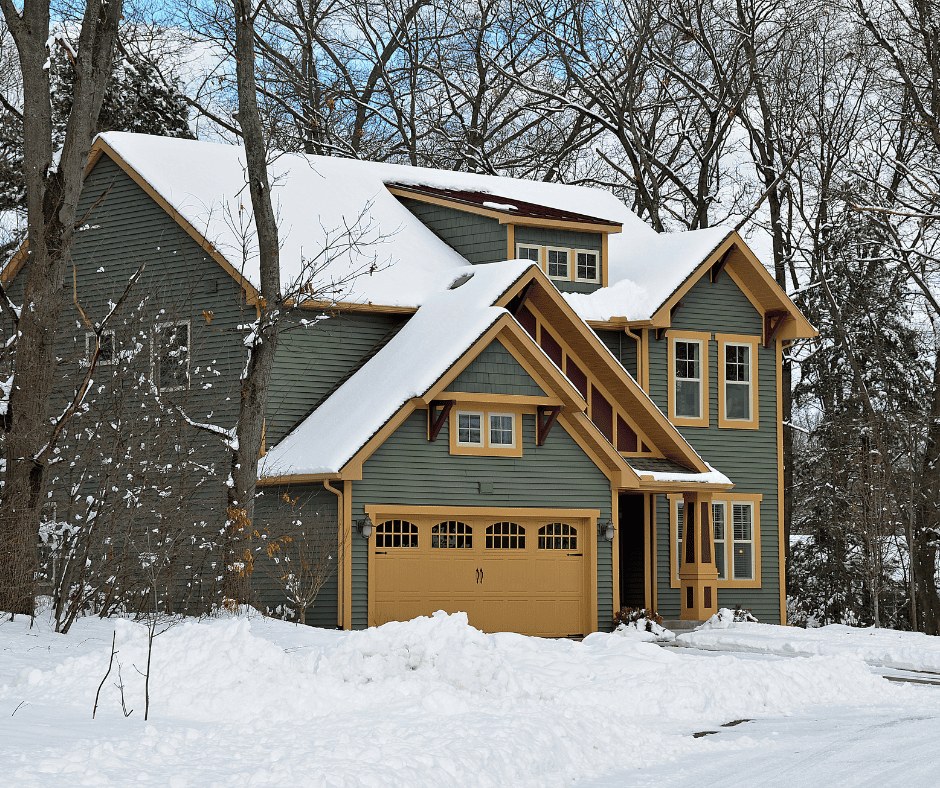When you are a homeowner, maintaining the integrity and safety of your home is a year-round job, with each season bringing its own set of challenges and requirements.
Winter, in particular, demands special attention. Preparing your home for the cold months is not just a matter of comfort but a crucial step in safeguarding against potential damages that can be both costly and hazardous. Additionally, staying on top of these items is in your best interest if you are selling your home in the winter months.
Our winter home maintenance checklist is designed to guide you through essential tasks. These measures help protect your home against the harsh winter elements and contribute to the ongoing upkeep necessary to preserve your home’s value and functionality.
From ensuring your heating system runs efficiently to preventing frozen pipes and securing the exterior against winter storms, each item on this checklist is a proactive step in fortifying your home for the season ahead.
Heating System
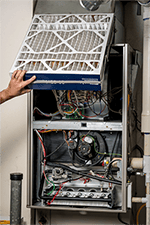
Let’s start with your heating system. Since this is that one system tends to fail when you need it most, it should probably be the first thing you look at.
It’s probably best to have an HVAC professional clean, service, and inspect your furnace. A gas furnace can leak carbon monoxide and natural gas.
HVAC pros have meters that can sniff out trace amounts of carbon monoxide. One good option is to alternate having a professional look at your system and doing it yourself between seasons.
Learning to service a forced-air natural gas furnace is a good skill for a homeowner. Inspections should be performed annually to ensure efficiency, safety, and longevity.
Here’s a step-by-step guide:
- Turn Off the Power and Gas Supply: Before starting any work, ensure the power to the furnace is turned off at the main switch and the gas supply is shut off.
- Inspect the Furnace: Look for any signs of rust, damage, or wear in and around the furnace.
- Change the Air Filter: Replace or clean the furnace’s air filter. A clogged filter can restrict airflow and reduce efficiency.
- Clean the Blower Assembly: Remove the front panel of the furnace to access the blower assembly. Clean the blower and its components with a soft brush and vacuum.
- Check the Fan Belt: While most modern furnaces are direct drive, older units might have a belt that drives the fan. Inspect the fan belt for any signs of fraying or cracking. Replace if necessary.
- Clean the Burner and Flame Sensor: Carefully clean the furnace burners with a vacuum or soft brush. Clean the flame sensor with a fine emery cloth to ensure it can accurately detect if the burner is lit.
- Inspect the Heat Exchanger: Look for any cracks or signs of wear. A damaged heat exchanger can be a serious safety hazard and should be addressed immediately by a professional.
- Lubricate Moving Parts: As specified in the furnace’s manual, apply lubricant to any moving parts, like bearings or motors.
- Check the Flue Pipe: Inspect the flue pipe for any signs of corrosion, holes, or blockages. Ensure it’s securely connected and venting correctly.
- Test the Furnace: Turn the power and gas back on after reassembling. Watch the furnace cycle to ensure it ignites, runs, and shuts off properly.
- Inspect and Test Safety Controls: Ensure all safety controls, like the high limit control and pressure switch, function properly.
- Check and Adjust the Thermostat: Ensure your thermostat works correctly and set it for optimal winter temperatures.
Consider Professional Inspection: For a comprehensive check, consider hiring a professional to inspect and service your furnace, especially for checking gas connections and combustion-related components.
Remember, safety is paramount. If you need more clarification or clarification about any step, it’s advisable to contact a professional technician. Regular professional servicing is recommended to maintain the efficiency and safety of your furnace.
Reverse The Direction of Your Ceiling Fans
Reversing the direction of your ceiling fans during the winter months is a simple yet effective way to enhance the efficiency of your home’s heating.
In the summer, ceiling fans typically spin counterclockwise to create a cool breeze, but in winter, setting them to spin clockwise at a low speed can be beneficial. This reverse motion pulls cool air up and pushes down the warm air, which naturally rises to the ceiling back down into the room.
This redistribution of warm air is especially beneficial in rooms with high ceilings and can lead to a more even and comfortable temperature throughout the space. By circulating the warm air more effectively, you can reduce the strain on your heating system, leading to potential energy savings as your heater doesn’t need to work as hard to heat the entire room.
This small adjustment to your ceiling fans can, therefore, make a noticeable difference in both your comfort and heating bills during the colder months. This is just one way you can save energy over the winter. Here are 17 additional ways you can save on energy during the winter.
Insulating Your Home
Improving the insulation in your home, particularly in walls and attics, is essential for enhancing energy efficiency, minimizing heat loss, and maintaining comfort during colder months.
To ensure your insulation is up to par, inspect your attic for signs of insufficient insulation, like visible ceiling joists or patchy coverage, and add insulation material as needed for a uniform layer. Check walls for cold spots using an infrared thermometer, indicating potential areas of inadequate insulation.
Equally crucial is the sealing of windows and doors, as they are common sources of drafts. Your local hardware store should carry simple DIY solutions like weather stripping or caulk that can seal these gaps effectively.
Additionally, using thermal curtains or draft stoppers can further bolster insulation. These steps not only maintain a warm, comfortable indoor environment but also significantly save energy bills and heating costs by reducing the energy needed to heat your home.
Effective insulation and sealing are important components of a well-maintained, energy-efficient home.
The water heater is another place you can improve energy efficiency in your home. Incorporating the insulation of your water heater into your winter home maintenance can lead to notable energy savings and efficiency.
Wrapping your water heater in an insulation blanket is a simple yet effective step, particularly beneficial for older models. As per the U.S. Department of Energy, this practice can reduce standby heat losses by 25-45%.
Consequently, this can translate into approximately 4-9% savings in your utility bills. By adding this measure to your winterizing routine, you not only enhance your home’s energy efficiency but also contribute to significant cost savings over the colder months.
Plumbing Precautions
Preventing a burst pipe from freezing during cold weather is a critical aspect of winter home maintenance, as frozen pipes can lead to bursts, resulting in costly damage from flooding when things warm back up.
To safeguard against this, start by draining water from outdoor faucets and irrigation systems, which are the most susceptible to freezing.
Shut off the water supply to these outdoor lines and open the faucets to allow any remaining water to drain out, effectively removing the risk of water freezing and expanding inside these pipes.
Insulation is key for pipes inside your home, particularly those in unheated areas like basements, crawl spaces, and garages. Use foam pipe insulation sleeves, which are easy to install and provide a protective layer against the cold.
Pay special attention to pipes running along exterior walls, as these are more prone to freezing. For extra precaution during extreme cold spells, consider letting a trickle of water run from the faucets connected to exposed pipes. This movement of water can prevent freezing.
In addition to insulating exposed pipes, sealing gaps and openings where pipes run through walls or floors can further reduce the risk of freezing. Use caulk or insulation to block drafts, particularly when pipes enter the home.
These proactive steps can significantly reduce the risk of frozen pipes, safeguarding your home from potential water damage and ensuring a smoother, worry-free winter season.
As winter snow melts, the risk of flooding increases, making it crucial to inspect your sump pump during winter maintenance. A sump pump removes water from under and around your home, preventing pooling near the foundation, which can cause flooding and structural damage.
Homeowners can perform basic maintenance and testing to prevent failures during critical periods, as outlined in the sump pump’s owner’s manual. This proactive approach is key to safeguarding your home against water damage.
Roof and Gutter Maintenance
The importance of cleaning gutters and downspouts, particularly in preparation for the winter months, cannot be overstated. Clogged gutters can lead to water overflow, causing damage to your home’s foundation, siding, and landscaping.
This can be exacerbated in winter as trapped water freezes, forming ice dams that weigh down and damage gutters, potentially leading to water seeping into the home.
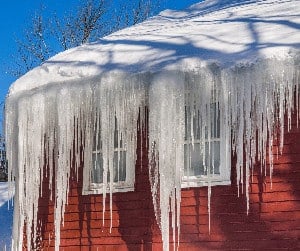
Regular cleaning of gutters and downspouts ensures proper water drainage, preventing these costly issues.
Additionally, inspecting the roof for damaged or missing shingles before winter sets in is important. Compromised shingles can lead to leaks and water damage, further aggravated by winter conditions. Snow and ice can seep through these vulnerable spots, causing significant damage to the roof structure and interior of the home. Early detection and repair of such issues are crucial to maintaining the roof’s integrity and avoiding the hassle of installing a new roof.
Using gutter guards and heating cables is also effective in winter home preparation. Gutter guards prevent the accumulation of leaves and debris, minimizing the need for frequent cleaning and reducing the likelihood of clogs. Heating cables, or heat tapes, can be installed along gutters and downspouts to prevent the formation of ice dams. They maintain a consistent temperature, ensuring snow and ice melt and drain properly rather than refreezing in the gutters.
In summary, proper gutters, downspouts, and roofing maintenance is essential in winter preparations. These steps protect your home from water damage and leaks and enhance the overall longevity and efficiency of your home’s exterior drainage and roofing systems. Regular upkeep, combined with preventive measures like gutter guards and heating cables, can significantly ease the challenges of winter weather.
Fireplace and Chimney Care
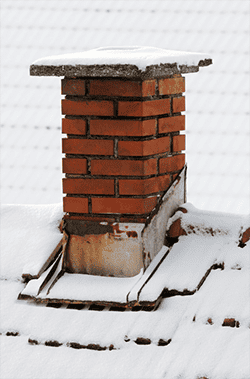
As winter approaches, the cozy ambiance of a crackling fireplace becomes a central part of many homes, emphasizing the importance of preparing your fireplace and chimney for the season.
Regular inspection and cleaning of the chimney are crucial. Creosote, a highly flammable byproduct of wood burning, accumulates in the chimney and can lead to dangerous fires if not regularly removed.
A professional chimney sweeper can clean and inspect the chimney for any blockages, creosote buildup, or structural issues, ensuring it’s safe to use.
Equally important is the inspection of fireplace dampers and firebricks. To control airflow and maximize efficiency, the damper must be operational, opening and closing smoothly.
It also needs to be fully open when the fireplace is in use to allow smoke and gases to escape. Checking the firebricks lining the fireplace for any cracks or deterioration is vital, as damaged firebricks can reduce the fireplace’s safety, allowing heat to reach combustible parts of the house.
When using a wood-burning fireplace, following safe usage tips is key. Only burn dry, seasoned wood, as it produces more heat and less creosote buildup than wet or green wood.
Avoid overloading the fireplace; smaller, more controlled fires generate less smoke and are safer. Always use a fireplace screen to prevent embers from escaping, and never leave a fire unattended.
Also, ensure your home has working smoke alarms and carbon monoxide detectors.
Preparing and maintaining your fireplace and chimney ensures a safe and enjoyable experience throughout the winter months, keeping your home warm while minimizing risks. Regular maintenance and adhering to safe usage practices are essential for the efficient and safe operation of your wood-burning fireplace.
Sealed Gas Fireplaces
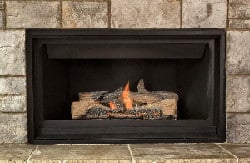
Wood fireplaces aren’t the only fireplaces that require attention. A sealed gas fireplace can develop carbon monoxide leaks for several reasons: improper ventilation, faulty seals or gaskets, malfunctioning or dirty burners, cracks in the heat exchanger, exhaust backdrafts, incorrect gas pressure or mixture, and general wear and tear over time.
These issues can lead to incomplete combustion or improper venting of combustion gases, including carbon monoxide. Regular maintenance and inspections by qualified professionals are crucial to identify and fix these issues, ensuring the safe operation of the fireplace.
Here’s what you need to do to ensure your sealed gas fireplace is safe for the winter heating season:
- Install Carbon Monoxide Detectors: Place CO detectors near the fireplace and in sleeping areas.
- Conduct a Visual Inspection: Examine the fireplace’s seals and vents for damage or deterioration. Look for soot, which can indicate incomplete combustion.
- Observe the Flame Color: A blue flame is normal; yellow or orange flames can suggest incomplete combustion, leading to CO production.
- Schedule Professional Inspections: Have a qualified technician perform annual maintenance and specifically check for CO leaks.
- Be Aware of CO Poisoning Symptoms: Headaches, dizziness, and nausea. If suspected, seek fresh air and medical attention immediately.
- Avoid DIY Repairs: For any suspected issues, always consult a professional.
- Ensure Proper Ventilation: Keep the room with the fireplace well-ventilated.
- Maintain CO Detectors: Regularly test and maintain your CO detectors to ensure they are functional.
Regular maintenance and monitoring are crucial for detecting and preventing CO leaks in sealed gas fireplaces.
Exterior Checks
Checking the exterior of your home before winter is a crucial step in preparing for the colder months. This process includes several important tasks to ensure your home remains safe and efficient throughout the season.
Firstly, securing or storing outdoor furniture and equipment is essential. Winter weather can be harsh, and items left outside may get damaged or become potential hazards during strong winds or storms.
Storing furniture, grills, and garden tools in a shed or garage protects them from the elements and prolongs their lifespan. It also clears the space for snow removal and prevents any objects from being buried under snow.
All garden hoses should be removed from their spigots and stored in a warm, dry location. Additionally, if you have an automatic sprinkler system, it should be winterized. In areas that experience severe cold, you should also “blow out” the system with pressurized air to make sure water doesn’t get caught in a place where it could freeze and crack a part of your system.
Inspecting your home’s siding for cracks or damage is another important step. Cracks or holes in the siding can lead to water infiltration, which in turn can cause significant damage to the structure of your home.
Moisture trapped in walls can lead to mold growth and insulation damage. Repairing any damage before winter can prevent these issues and improve your home’s insulation. Keeping the cold air out leads to better heat retention and lower energy costs.
Lastly, the importance of outdoor lighting becomes more pronounced in winter due to the shorter days and longer nights. Well-lit exteriors are crucial for safety to avoid slips and falls on icy paths and serve as a deterrent against burglaries, which tend to increase during the darker months. Ensuring all outdoor lights are functional and installing motion-sensor or timed lighting systems can provide security and safety throughout the winter.
In conclusion, thoroughly checking and preparing your home’s exterior before winter can prevent damage, enhance safety, and save costs. From protecting outdoor items to ensuring your home is well-lit and insulated, these steps are vital in preparing for the challenges of the winter season.
Emergency Preparedness
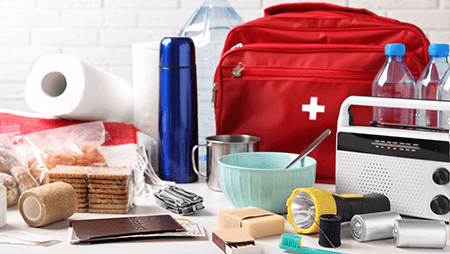
Being prepared for severe winter storms is paramount, as these storms can bring extreme cold, heavy snowfall, ice, and strong winds, often leading to power outages, transportation disruptions, and hazardous conditions. In such scenarios, being well-prepared can make a significant difference in ensuring the safety and well-being of you and your family.
One of the key steps in winter storm preparedness is creating a winter emergency kit. This kit should include flashlights, extra batteries, blankets, warm clothing, a first-aid kit, and basic medical supplies. Having these items readily accessible can be a lifeline during a power outage or if you cannot leave your home due to severe weather conditions.
In addition to the emergency kit, considering a backup power solution, such as a generator, can be a wise decision. Generators can provide critical power to keep your heating system, refrigerator, and lights operational during a power outage.
It’s important to understand the type of generator that best suits your needs and to follow safety guidelines for its use, such as ensuring proper ventilation to prevent carbon monoxide poisoning. Furthermore, keeping a stock of non-perishable food and water is crucial.
This stockpile should include a variety of foods that require no cooking or refrigeration and a sufficient water supply for each household member. The rule of thumb is to have at least a three-day food and water supply.
Overall, the unpredictable nature of winter storms requires a proactive approach to preparedness. By assembling an emergency kit, planning for backup power, and stocking up on essential supplies, you can significantly mitigate the risks of severe winter weather. These preparations provide peace of mind and equip you with the necessary resources to remain safe and comfortable until conditions improve.
Smart Home Updates
Incorporating Smart Home technologies becomes particularly beneficial during the winter months, offering enhanced control, efficiency, and safety in managing home environments under the unique challenges posed by colder weather.
Smart thermostats are a standout feature in this context. During winter, these devices are invaluable for maintaining optimal indoor temperatures efficiently. They adjust heating settings based on your daily routine and can react to sudden drops in temperature, ensuring your home stays warm and comfortable while minimizing energy waste.
This is environmentally friendly and significantly saves on heating bills, a notable concern during the colder months.
Smart lighting and security systems also gain added importance in winter. With shorter days and longer nights, smart lighting can be programmed to reflect the reduced daylight hours, enhancing your home’s safety and ambiance.
Motion-activated lighting is particularly useful in winter, illuminating icy walkways and entry points, thereby reducing the risk of accidents. Smart security systems, with their remote monitoring capabilities, provide reassurance during a season when homes might be left unoccupied for extended periods, especially during holiday travels.
The winter also increases the risk of water damage due to frozen and burst pipes. Here, smart leak detectors and automatic shut-off systems are crucial. These systems can immediately alert homeowners to any water leaks, which are more prevalent in winter due to the strain on pipes. Some advanced systems can even automatically shut off the water supply, preventing extensive water damage, which is especially valuable if a leak occurs when the homeowner is away, perhaps on a winter vacation.
In summary, Smart Home updates can significantly ease the challenges of winter home management. From ensuring efficient heating and reducing energy costs with smart thermostats to enhancing safety and security through intelligent lighting and monitoring systems and preventing water damage with innovative leak detection technology, these smart solutions offer a more controlled, efficient, and secure home environment during the demanding winter months.
In Conclusion
As we’ve explored throughout this article, the importance of winter home maintenance cannot be overstated. It is the key to ensuring a safe, comfortable, and efficient home environment during the harsh winter. From preparing your HVAC system and plumbing to prevent freezing to inspecting and fortifying your home’s exterior and roof, each step plays a crucial role in safeguarding your home against winter’s challenges.
The onset of winter brings a unique set of demands, and starting your preparations early is the best strategy to ensure you are fully ready. Proactive maintenance can prevent the stress and high costs of emergency repairs during the cold season. Remember, winter maintenance is about immediate comfort and protecting your investment in your home and ensuring its longevity.
As a final tip, remember that the little things can make a big difference. Simple actions like checking your smoke detectors, keeping an emergency kit ready, and ensuring your home is properly insulated can greatly enhance your safety and comfort. And for a comprehensive guide through this process, don’t forget to download our Winter Home Maintenance Checklist. This checklist will be a handy guide to help you cover all essential aspects of winter home maintenance, ensuring nothing is overlooked.
By staying prepared and following these guidelines, you can enjoy the winter season with peace of mind, knowing your home is well-cared for and ready to provide a warm, safe haven for you and your loved ones.

